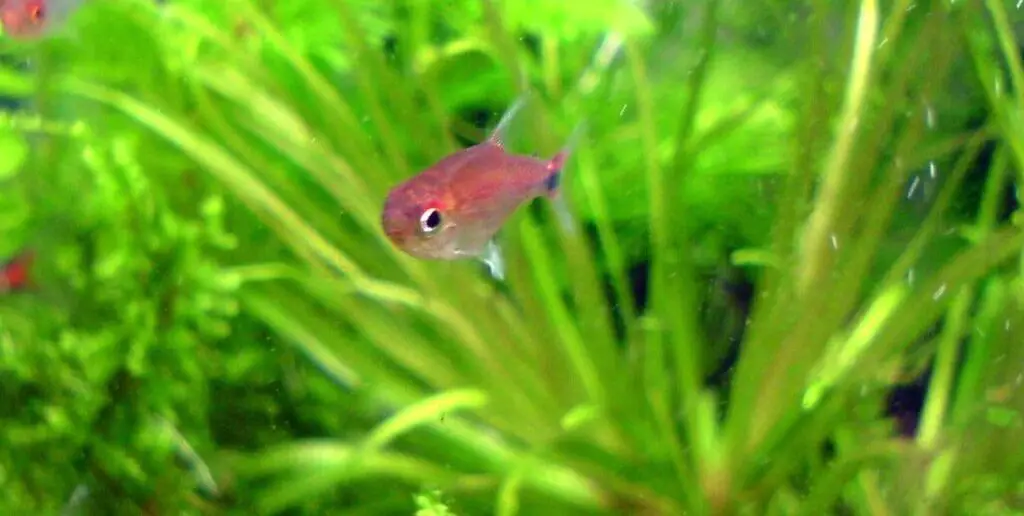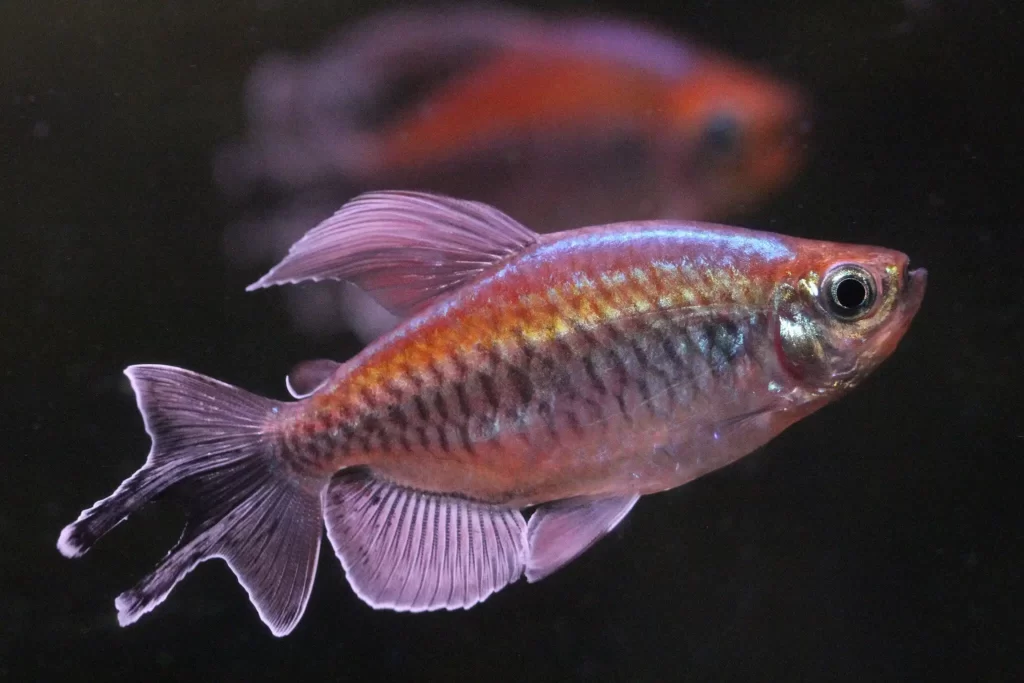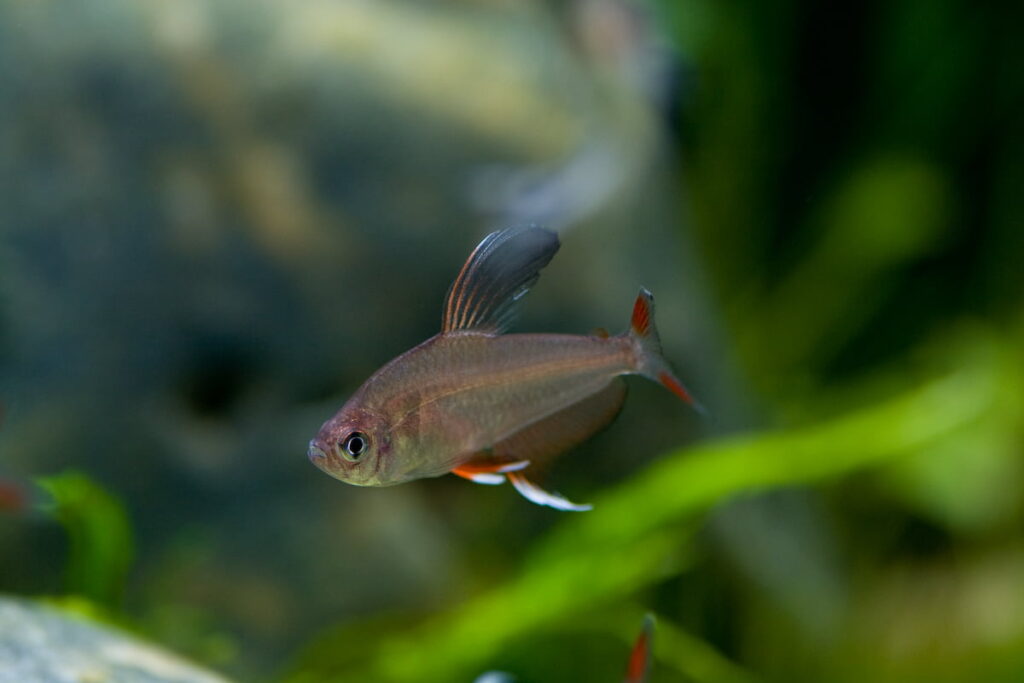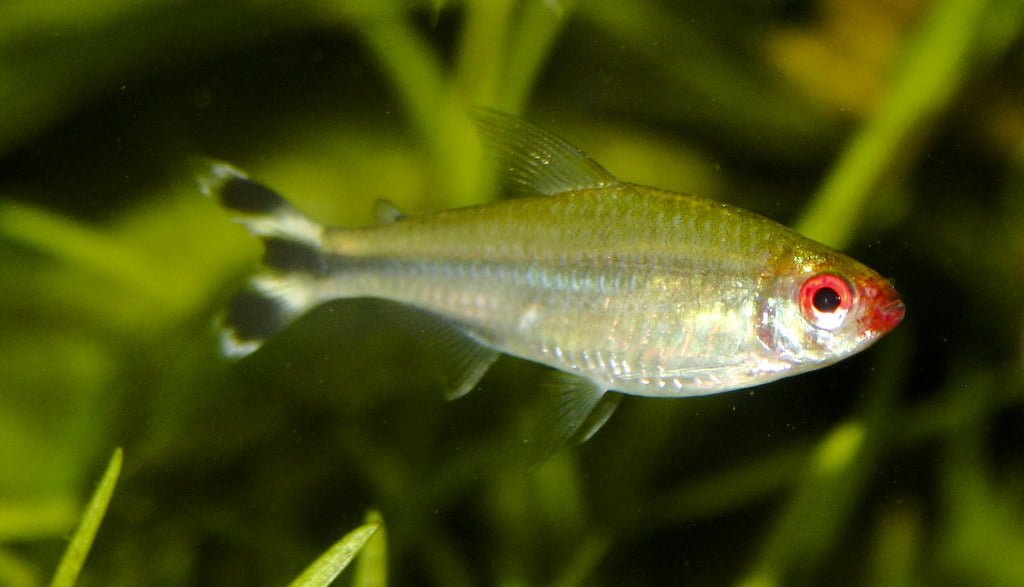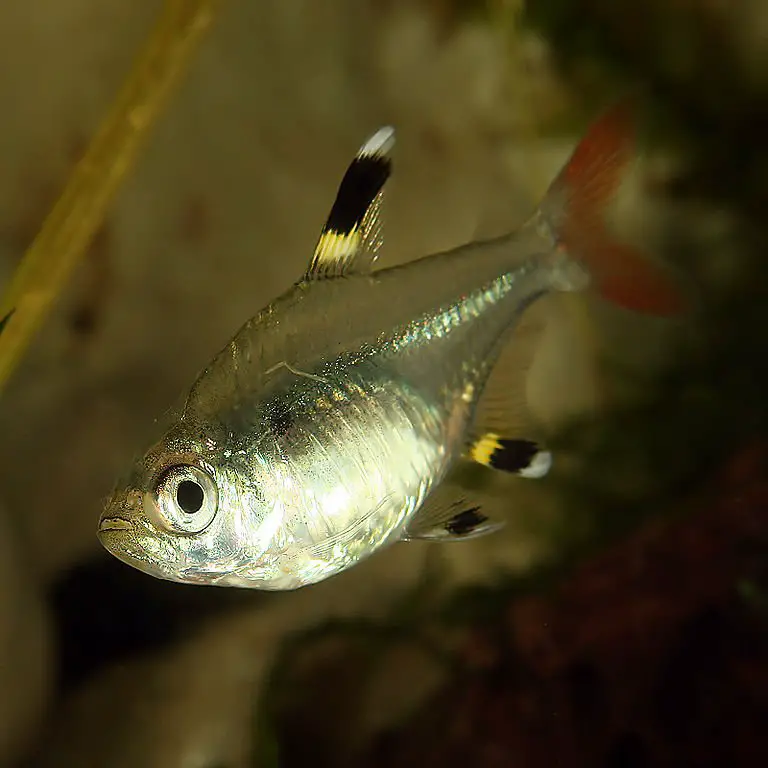So, last night I visited a friend who happened to have a freshwater tank. I glanced at it and it felt like it needed some fun, some color, and a little bit of activeness. Seems like I have in mind exactly what the tank needed i.e. a little spark of ruby lightning called Ruby Tetra. The Ruby Tetra is the perfect ruby pigmented Tetra that can fit in a freshwater tank like a glove.
Ruby Tetra, freshwater subtropical characin, is a small genus of Tetra which stands out in any aquarium with its beautiful appearance. This active species of Tetra is suitable for a planted freshwater tank as it does not take up much space and is very peaceful in nature. Hence, the Ruby Tetra is named after its ruby red pigment and is one of the best choices of Tetra for planted tanks. Some might even say that this stunning little Tetra resembles rasboras.
Here’s all you need to know about this species. Let’s see what makes them the perfect shade of ruby red for your freshwater aquarium.
Ruby Tetra: A Brief Description
The Ruby Tetra(Axelrodia riesei) is a species of freshwater fish in the family Characidae. Dating back to its discovery in 1988, this Tetra is an inhabitant of leaf litter and floating plants with clean yet acidic water rich in tannins. It originated from the upper Río Meta, Colombia, South America.
Ruby Tetra are comparatively hard to breed. It requires specific tropical climates for survival. Therefore, Ruby Tetra is not frequently available.
Ruby Tetra can be distinguished by its small ruby red tinted body, transparent fins and a black spot at the end of its tail. It shows a faded red and orange color when captivated, however, regains it once it has suitable conditions to live in. Ruby Tetra are comparatively smaller in size and can grow up to 1.6 inches (4 cm) approximately.
This fish can survive up to a maximum of 10 years if taken care of properly. Ruby Tetra has a lifespan of 5-10 years on average. As a matter of fact, Ruby Tetra like other Tetra species shows sexual dimorphism. The males tend to be rather smaller and brighter while the females are rounder and bigger.
A single Ruby Tetra can cost you around $3 in the market. Since they are a shoaling species rather than most schooling Tetra, it is best to keep them in a group of at least 8. A group of 10 might cost you around $27. Besides this, premium bred Ruby Tetras are also available that have an enhanced overall like in color and activeness, and are twice as costly as they are normally.
Social Behavior and Tank Mates
Ruby Tetra are peaceful and shoaling species rather than most schooling Tetras. However, they are territorial in nature. This is what makes them shoaling rather than a schooling species. For starters, they are shy in nature which makes them sociable yet not exactly a community fish. Besides, Ruby Tetra should be kept in a tank along with its own species. Keeping a group might show you some of its territorial behavior as well.
Ruby Tetra, due to their small size and requirements, can be paired with only fewer genus of fish, although they are recommended to be kept alone. Tank mates for this Tetra include Corydoras catfish, Otocinclus spp., dwarf cichlids, pencil fish, and other small blackwater tetras like Neon Tetra. Small Asian Rasbora, Boraras, invertebrates, and Kuhli loaches get along well with the fish as well. Rather, one must be careful while choosing which fish to pair with.
Summing up, small and peaceful species of fish go along well with this Tetra. A group of 8 or 10 is best recommended for the fish.
Fish Keeping Difficulties
One might even consider Ruby Tetra as an exotic Tetra for its size and appearance. However, with this comes the fish keeping difficulty. Ruby Tetra requires a lot of maintenance from creating a suitable environment and diet from beginning to the end.
Ruby Tetra is a delicate species of Tetra. It requires specific conditions to live in and is quite needy. It is comparatively harder to look after than most Tetras. Also, Ruby Tetra requires special care during the breeding process. You need to consider special and controlled care for the Tetra including the diet if you plan to keep it with other species.
It is evident that Ruby Tetra is not the easiest breed to handle. The fish is comparatively harder to handle and on top, it needs a smaller tank as it likes to be kept alone. Therefore, previous experience in fish keeping would help a lot in situations and the fish is definitely not for a newbie, unless a very dedicated one.
Caring For Ruby Tetra
Having a fish is just like having a baby except for the fact that Ruby Tetra looks like an actual baby when you get them premature. This tiny delicate Ruby Tetra is not a hardy fish. This means you need to pay extra attention to the fish. Also, the fish has it’s own demands as well.
Here’s all you need to be aware of while caring for Ruby Tetra in your freshwater tank.
Tank
Tank set up for the Ruby Tetra can be quite a debating topic. A lot of elements come into consideration when you have a delicate Tetra that demands to be kept alone for it’s worth.
Firstly, you need to know that this species is an inhabitant of black water. A tank suitable for this can be a basic bioptic tank with black water which has a minimum capacity of 10 gallons. A 10-gallon tank with the rule of thumb can sustain a thriving group of 8-10 Ruby Tetra.
The Ruby Tetra is a middle and top dweller. One thing with Tetra is that you need to have a secure lid at all times in your tank. Above all, having a group of 10 might show you some of its interesting territorial behavior.
Read Full Article on How Many Neon Tetra in a 10 Gallon Tank. This is applicable for false penguin tetras too.
Fact: Bigger the tank, the easier it is to maintain.
Lighting
Lighting should be adjusted as per the species of the fish, and all Tetra fish usually prefer a dim lighting environment. This is because a vital factor is played by lighting in the performance of any fish.
Since the natural habitat of Ruby Tetra is in the presence of leaf litter and floating plants, they require moderate lighting. They tend to do well in a shaded environment with dim lights. In the case of brighter lights, you can incorporate floating plants so as to create shades for a more natural feel since the fish dwell at the top and middle level of the water column. This will hence help you create a balanced ecosystem.
Lower output LED lights, in addition to plants that do well in darker conditions, should be incorporated.
Substrate and Decor
Adding a substrate and decoration to any tank should be done according to the fish’s natural habitat. On the other hand, this will allow the fish to be more comfortable and stress-free therefore helping it keep its natural instinct.
Ruby Tetra prefers a sandy substrate with heavily planted decor. While it is best to keep a darker shaded substrate which will definitely make the Ruby Tetra pop. As a result, it is necessary to make sure that the fish has enough hiding places. However, make sure that the spaces are not too dense.
Plants like Microsorum, Taxiphyllum or Cryptocoryne spp. And floating vegetation like Ceratopteris spp. can survive in similar water conditions. Likewise having heavy driftwood and peat moss is also a bonus as the fish enjoy tannins and tend to do well.
Fact: Ruby Tetra tends to hide in spaces a lot. Many people have consequently complained that the fish come out only during feeding time.
Diet
Tetra is a species which is known for its vibrant color and activeness. This can be maintained with a healthy diet.
Ruby Tetra is not fussy or picky about their food. They are omnivorous in nature. In the wild, they feed on small insects, invertebrates and zooplankton. A varied diet consisting of high-quality flake food, pellets, and live, frozen, or freeze-dried Artemia, micro worms, Tubifex, Daphnia, etc is the best to maintain a healthy glow.
Above all, it is important to feed them in small amounts at least twice a day.
Read Full Article on Tetra Fish Diet.
Did you know?
There are color enhancing foods available for fish!
Water Quality Maintenance
For healthy livestock, maintaining the quality of water is an important factor. Water quality is open to many changes especially in the number of minerals as well as the addition of unwanted toxins. Therefore, for having a fish, one must be concerned with quality.
Read Full Article on How to clean the tetra fish tank.
Ruby Tetra are usually kept alone. This means that it is easier to maintain the required conditions without having to worry about the requirement overlap of other fish. However, if you plan to keep another species, let’s see what Ruby Tetra environment must have:
Temperature
Ruby Tetra can survive at a temperature from 68° – 82.4° F (20° – 28° C). Similar to this, another species, Bloodfin Tetra also thrives at the same temperature.
A warmer temperature is a better option for Ruby Tetra in contrast to the highly tolerant cousins. In a tropical environment, it is not necessary to have a heater. But the temperature is a strict parameter for the fish.
Did you know?
During breeding, an increase in temperature can result in greater activity.
Hardness
Ruby Tetra are known to have a less tolerance range in terms of water hardness. These Tetras can survive within a range of only 3-12 dKH. This means the number of unrefined minerals in water needs to be less.
A water testing kit always comes in handy for this purpose.
pH
Ruby Tetra prefers a slightly acidic environment. A pH level of 5.0-7.0 is the level of tolerance. Despite the fact that Tetra is hardy and tolerant as well as adaptable, Ruby Tetra is a little different.
Tip: Always have a water testing kit for any fish.
Filtration
The growth of a bacterial colony in any aquarium is inevitable. Along with this is the growth of unwanted elements like carbon dioxide, nitrate as well as toxin buildup. To have a clean environment, filtration is a key factor.
A couple of different designed fish tank filters are available in the market being the internal and external type. Along with this is the filter media like biological media. As Ruby Tetra is small, you can consider having an internal filter with just enough suction capacity to not get a fish caught in it. Similarly, providing aeration is an important part.
If you plan to breed Ruby Tetra, for the fry you will need to lower the filter suction capacity so that the fry do not get sucked.
Regular water changes need to be maintained in a tank as Ruby Tetra only stay in clean water. A 10-25% partial water change every week is the minimum requirement for any tank. Along with this, trimming grown plants and vacuuming the substrate to clear out any biowaste is a good habit to keep the environment clean.
Fish Diseases
Diseases in fish are inevitable to any living being including fish. Even a well- maintained tank, fish are susceptible to diseases. Therefore, you need to take very careful steps while maintaining a tank.
Ruby Tetra is a delicate species of Tetra. Although it can survive up to 10 years, it is all because of the proper maintenance of the fish.
As a freshwater fish, Ruby Tetra can commonly be prone to following diseases:
- skin flukes,
- Ich,
- gene inherited diseases
- parasitic infestations,
- bacterial infections, etc.
Read Full article on Tetra Fish Diseases.
Therefore, no matter how much resilient or delicate your fish is, you need to be aware of the following things:
- Firstly, considering the fauna of the tank is an equally important parameter that can cause stress to the fish. In contrast, Ruby Tetra goes with a few species and should not preferably be kept with more than 3 species of fish.
- Creating a tank with similar habitat even similar to the original habitat can comfort your fish. Ruby Tetra likes a planted and heavy vegetative area. Certainly, be sure to provide them plenty of live plants.
- Bacteria and parasites can attach themselves to any surface. Any substance you introduce to your tank should be properly disinfected and soaked in water first.
- Regular partial water changes help reduce the disease and bacteria buildup.
- Maintaining a balanced diet is also a factor of having a healthy tank.
Note: If you notice that the fish is not well, immediately consider noting the symptoms, finding the disease, curing and quarantining and treating the fish. Most freshwater fish diseases can be treated.
For detailed information on such diseases and cures, visit my article on Disease And Treatment.
Breeding
Ruby Tetra is not always available in the market. It is comparatively hard to breed due to its delicate nature. On top, it cannot travel long distances. To breed this Tetra, you should maintain a controlled situation.
The base water condition for breeding Ruby Tetra includes an acidic environment with less KH. Hence, it is best to use treated water with a ROID unit and then adding acidic components.
Read Full Article on How to Breed Tetra Fish.
A finely planted tank with a small-sized aquarium is the best condition where the fish find enough space to breed. The temperature should be increased by a little and the lights should be made dimmer. Besides this, the fish is sensitive to organic waste. So, it is better not to introduce such items. Also, feeding the fish is equally important during the process.
However, having leaf litter is a good choice for the fry after the breeding process.
Ruby Tetra are egg scatterers. They do not take care of their eggs. The eggs are spread all over and are barely visible in clean water. If you want to remove the eggs, be very careful not to make harsh movements.
The breeding process can take anywhere from 24-48 hours. Generally, the rule is adding more females than males in a separate breeding tank so as to increase the rate. Spawning takes place on a daily basis over time. Therefore after the fish has laid eggs, you need to wait for a few days and then separate the parents. You need to do this since the fish can show cannibalism.
Tip: Do not introduce organic waste like moss as it can cause more harm.
Bonus: Adding leaf litter and surface cover can create microbe colonies that can serve as a food source to the small fry.
Check our article about tetra fry care.
Tetra Summary Chart
| Care Level | Easy |
| Origin | Colombia, South America |
| Behavior | Community and peaceful fish |
| Size | Approximately 1.6 inches (4 cm) |
| pH | 5.0-7.0, slightly acidic water |
| Temperature | 68° – 82.4° F (20° – 28° C) |
| Water hardness | 3 – 12 dKH |
| Lifespan | 5-10 years, depending on the size |
| Diet | Omnivorous, Micropredator |
| Minimum aquarium size | 10 gallon |
| Acquaintances | Similar sized fish like Platys, Corydoras Catfish, Honey Gouramis, Guppies, etc. |
Conclusion
One of the smallest species of Tetra which is as stunning as all the other fish is the Ruby Tetra. Furthermore, Ruby Tetra might have a few demands but you can be assured that it is definitely worth the keep. Ruby Tetras are a great keep for planted nano aquariums as well.
Certainly, Ruby Tetra will stand out in your planted freshwater aquarium with its beautiful ruby red essence. I hope you have found the importance of this hidden gem in your aquarium.
Reference
Image Credit:
- https://www.flickr.com/photos/swordw/1768525473(Sword)
